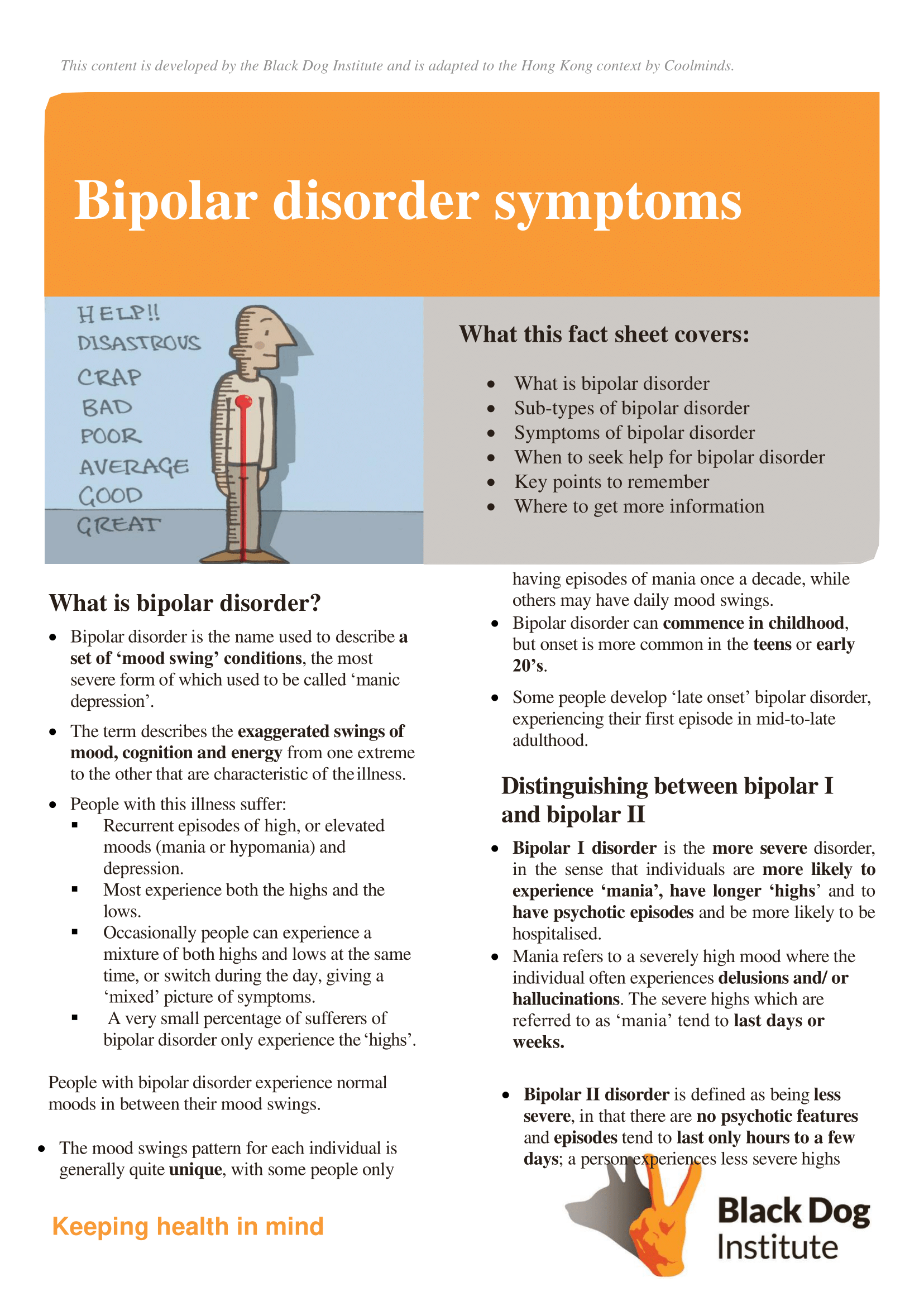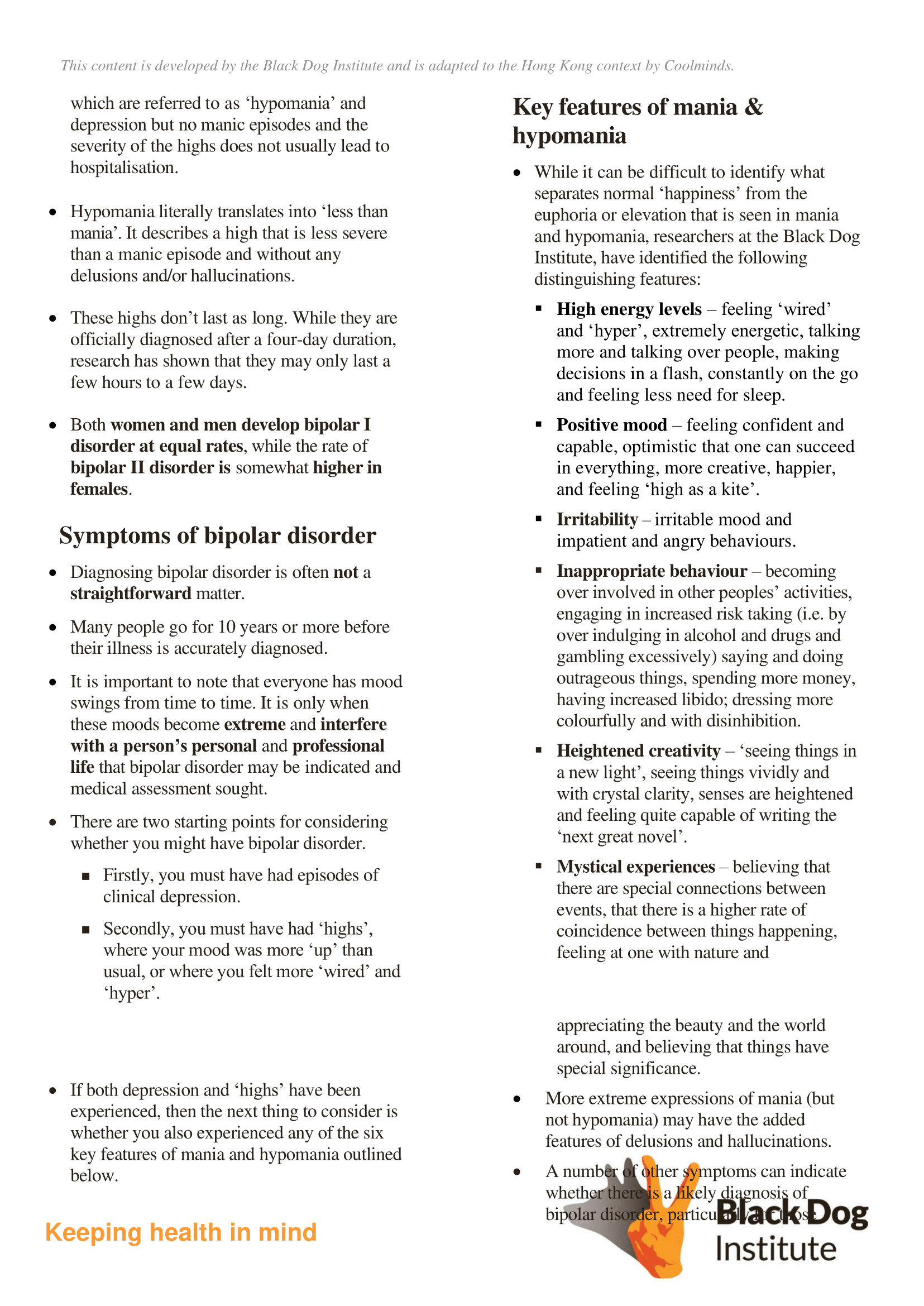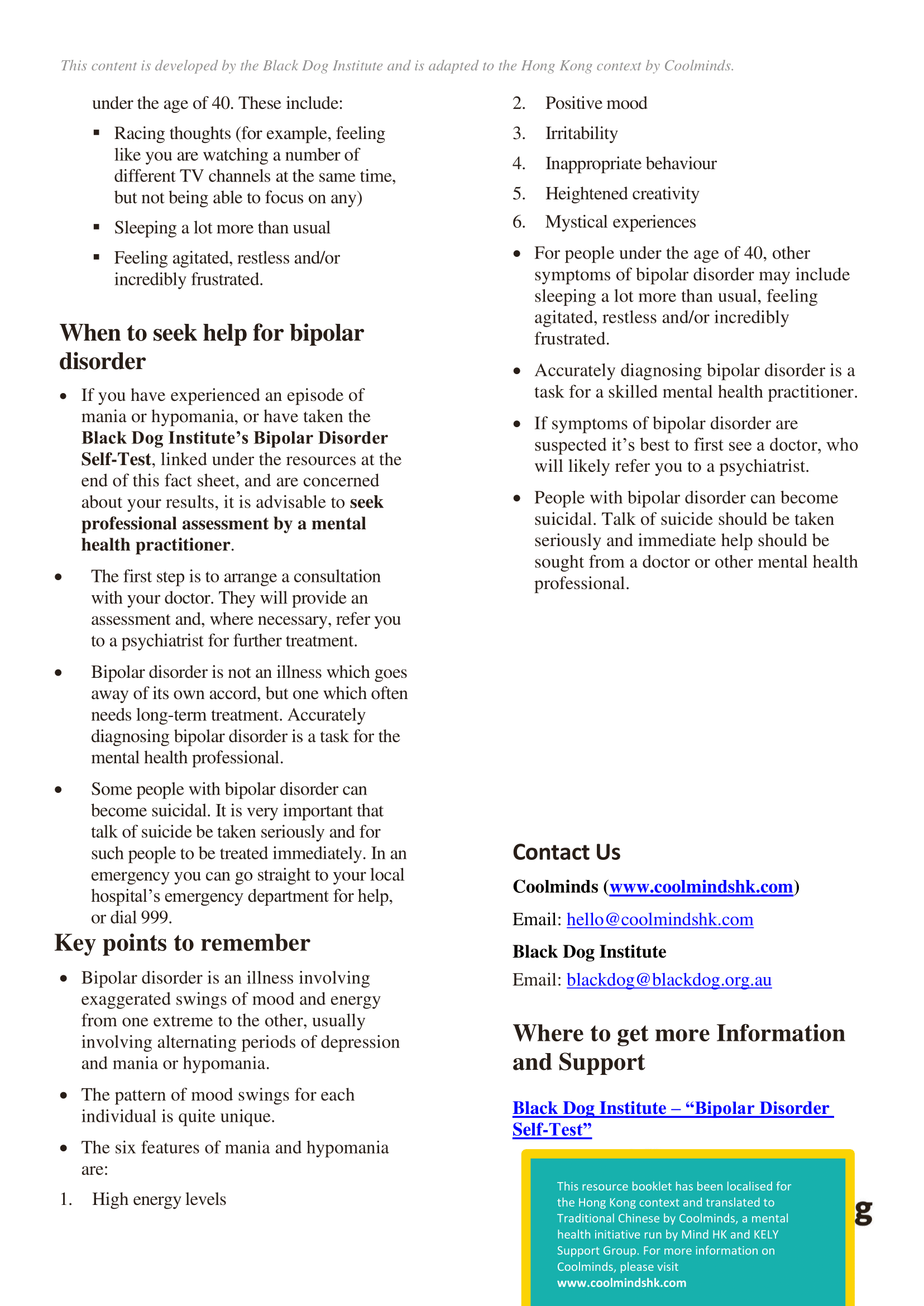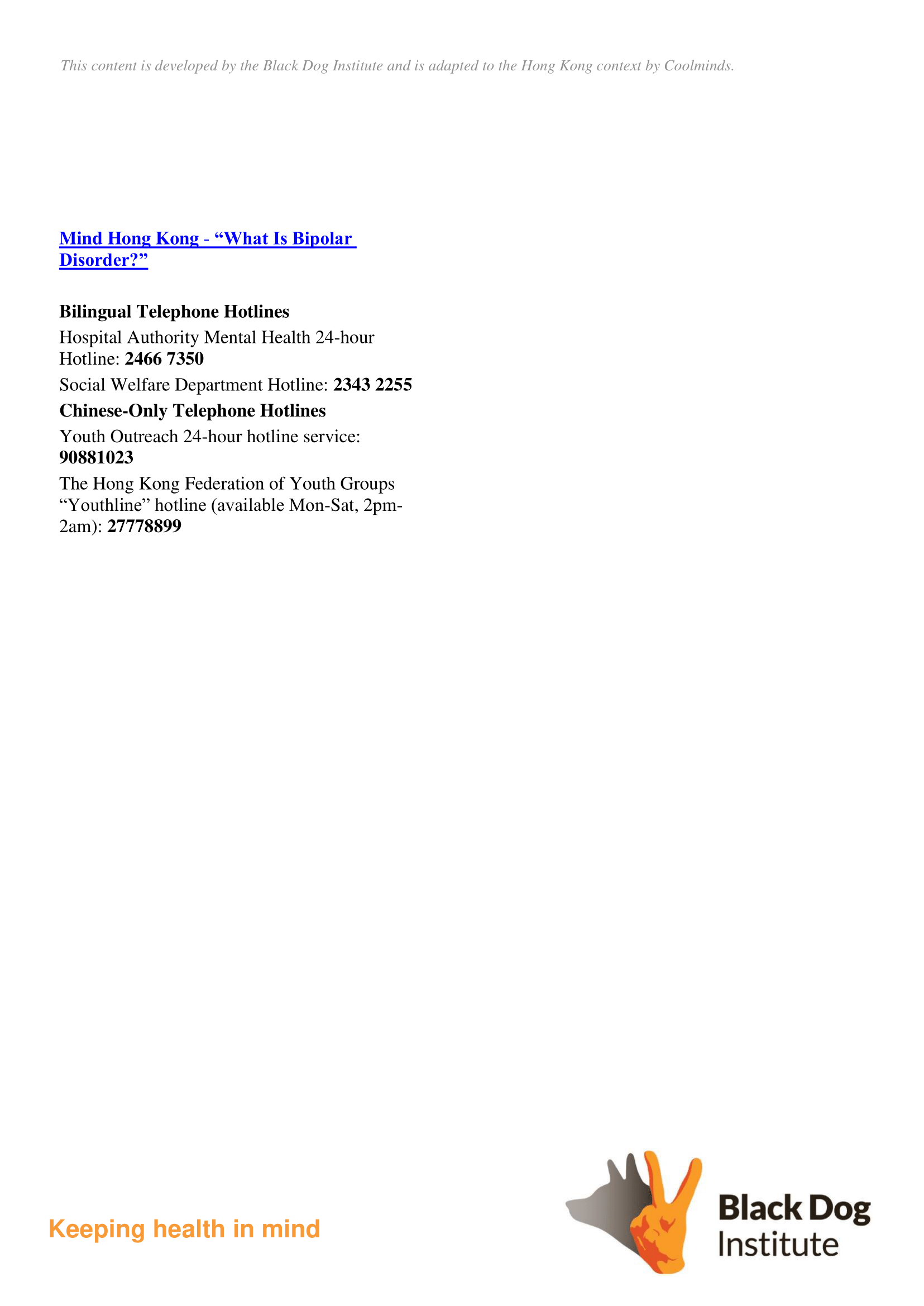This resource booklet has been localised for the Hong Kong context and translated to Traditional Chinese by Coolminds, a mental health initiative run by Mind HK and KELY Support Group. For more information on Coolminds, please visit www.coolmindshk.com
Thank you to the Black Dog Institute for donating their resources and for allowing us to adapt this. For the original version of this resource, please refer to the Black Dog Institute’s website: www.blackdoginstitute.org.au
What this fact sheet covers:
- What is bipolar disorder
- Sub-types of bipolar disorder
- Symptoms of bipolar disorder
- When to seek help for bipolar disorder
- Key points to remember
- Where to get more information
What is bipolar disorder?
- Bipolar disorder is the name used to describe a set of ‘mood swing’ conditions, the most severe form of which used to be called ‘manic depression’.
- The term describes the exaggerated swings of mood, cognition and energy from one extreme to the other that are characteristic of the illness.
- People with this illness suffer:
- Recurrent episodes of high, or elevated moods (mania or hypomania) and depression.
- Most experience both the highs and the lows.
- Occasionally people can experience a mixture of both highs and lows at the same time, or switch during the day, giving a ‘mixed’ picture of symptoms.
- A very small percentage of sufferers of bipolar disorder only experience the ‘highs’.
People with bipolar disorder experience normal moods in between their mood swings.
- The mood swings pattern for each individual is generally quite unique, with some people only having episodes of mania once a decade, while others may have daily mood swings.
- Bipolar disorder can commence in childhood, but onset is more common in the teens or early 20’s.
- Some people develop ‘late onset’ bipolar disorder, experiencing their first episode in mid-to-late adulthood.
Distinguishing between bipolar I and bipolar II
- Bipolar I disorder is the more severe disorder, in the sense that individuals are more likely to experience ‘mania’, have longer ‘highs’ and to have psychotic episodes and be more likely to be hospitalised.
- Mania refers to a severely high mood where the individual often experiences delusions and/ or hallucinations. The severe highs which are referred to as ‘mania’ tend to last days or weeks.
- Bipolar II disorder is defined as being less severe, in that there are no psychotic features and episodes tend to last only hours to a few days; a person experiences less severe highs which are referred to as ‘hypomania’ and depression but no manic episodes and the severity of the highs does not usually lead to hospitalisation.
- Hypomania literally translates into ‘less than mania’. It describes a high that is less severe than a manic episode and without any delusions and/or hallucinations.
- These highs don’t last as long. While they are officially diagnosed after a four-day duration, research has shown that they may only last a few hours to a few days.
- Both women and men develop bipolar I disorder at equal rates, while the rate of bipolar II disorder is somewhat higher in females.
Symptoms of bipolar disorder
- Diagnosing bipolar disorder is often not a straightforward matter.
- Many people go for 10 years or more before their illness is accurately diagnosed.
- It is important to note that everyone has mood swings from time to time. It is only when these moods become extreme and interfere with a person’s personal and professional life that bipolar disorder may be indicated and medical assessment sought.
- There are two starting points for considering whether you might have bipolar disorder.
- Firstly, you must have had episodes of clinical depression.
- Secondly, you must have had ‘highs’, where your mood was more ‘up’ than usual, or where you felt more ‘wired’ and ‘hyper’.
- If both depression and ‘highs’ have been experienced, then the next thing to consider is whether you also experienced any of the six key features of mania and hypomania outlined below.
Key features of mania & hypomania
While it can be difficult to identify what separates normal ‘happiness’ from the euphoria or elevation that is seen in mania and hypomania, researchers at the Black Dog Institute, have identified the following distinguishing features:
- High energy levels – feeling ‘wired’ and ‘hyper’, extremely energetic, talking more and talking over people, making decisions in a flash, constantly on the go and feeling less need for sleep.
- Positive mood – feeling confident and capable, optimistic that one can succeed in everything, more creative, happier, and feeling ‘high as a kite’.
- Irritability – irritable mood and impatient and angry behaviours.
- Inappropriate behaviour – becoming over involved in other peoples’ activities, engaging in increased risk taking (i.e. by over indulging in alcohol and drugs and gambling excessively) saying and doing outrageous things, spending more money, having increased libido; dressing more colourfully and with disinhibition.
- Heightened creativity – ‘seeing things in a new light’, seeing things vividly and with crystal clarity, senses are heightened and feeling quite capable of writing the ‘next great novel’.
- Mystical experiences – believing that there are special connections between events, that there is a higher rate of coincidence between things happening, feeling at one with nature and appreciating the beauty and the world around, and believing that things have special significance.
- More extreme expressions of mania (but not hypomania) may have the added features of delusions and hallucinations.
- A number of other symptoms can indicate whether there is a likely diagnosis of bipolar disorder, particularly for those under the age of 40. These include:
- Racing thoughts (for example, feeling like you are watching a number of different TV channels at the same time, but not being able to focus on any)
- Sleeping a lot more than usual
- Feeling agitated, restless and/or incredibly frustrated.
When to seek help for bipolar disorder
- If you have experienced an episode of mania or hypomania, or have taken the Black Dog Institute’s Bipolar Disorder Self-Test, linked under the resources at the end of this fact sheet, and are concerned about your results, it is advisable to seek professional assessment by a mental health practitioner.
- The first step is to arrange a consultation with your doctor. They will provide an assessment and, where necessary, refer you to a psychiatrist for further treatment.
- Bipolar disorder is not an illness which goes away of its own accord, but one which often needs long-term treatment. Accurately diagnosing bipolar disorder is a task for the mental health professional.
- Some people with bipolar disorder can become suicidal. It is very important that talk of suicide be taken seriously and for such people to be treated immediately. In an emergency you can go straight to your local hospital’s emergency department for help, or dial 999.
Key points to remember
- Bipolar disorder is an illness involving exaggerated swings of mood and energy from one extreme to the other, usually involving alternating periods of depression and mania or hypomania.
- The pattern of mood swings for each individual is quite unique.
- The six features of mania and hypomania are:
- High energy levels
- Positive mood
- Irritability
- Inappropriate behaviour
- Heightened creativity
- Mystical experiences
- For people under the age of 40, other symptoms of bipolar disorder may include sleeping a lot more than usual, feeling agitated, restless and/or incredibly frustrated.
- Accurately diagnosing bipolar disorder is a task for a skilled mental health practitioner.
- If symptoms of bipolar disorder are suspected it’s best to first see a doctor, who will likely refer you to a psychiatrist.
- People with bipolar disorder can become suicidal. Talk of suicide should be taken seriously and immediate help should be sought from a doctor or other mental health professional.
Contact Us
Coolminds
Email: hello@coolmindshk.com
Black Dog Institute
Email: blackdog@blackdog.org.au
Where to get more information and support
Black Dog Institute – “Bipolar Disorder Self-Test”
Mind Hong Kong – “What Is Bipolar Disorder?”
Bilingual Telephone Hotlines
Hospital Authority Mental Health 24-hour Hotline: 2466 7350
Social Welfare Department Hotline: 2343 2255
Chinese-Only Telephone Hotlines
Youth Outreach 24-hour hotline service: 90881023
The Hong Kong Federation of Youth Groups “Youthline” hotline (available Mon-Sat, 2pm-2am): 27778899






